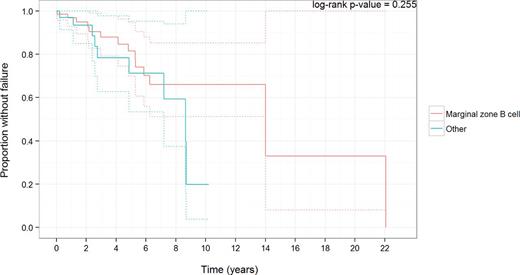Abstract
Background:
Lympho-proliferative disorders are among the most common neoplasms affecting the ocular adnexa. OALD represents 1% of all lymphomas and 10-15% of extra nodal presentations. The outcomes of local radiation therapy (RT) in MALT vs. non-MALT histology are not known. Herein we present outcomes of local therapy in MALT vs. non-MALT OALD treated at a specialized lymphoma program.
Methods:
The analysis included 112 consecutive patients (pts) with OALD diagnosed at our institution between 1975- 2014. Patient characteristics, treatment modality and the response to treatment were retrospectively collected. Histology was reviewed by an expert hematopathologist. The primary objective of the study was to assess the failure free survival (FFS) in pts with marginal zone lymphoma of mucosa associated lymphoid tissue (MALT) of ocular adnexa (OA) and non-MALT OA lymphomas treated with local radiation therapy. Complete remission was defined as absence of any disease by imaging. Local failure was defined as any failure within the OA; extra-orbital failure was either regional (within the radiation field) or distant (for cases with limited stage disease at presentation). FFS was defined as time from treatment to any failure (local, regional and distant) and overall survival (OS) as time from treatment to last follow up or death from any cause. FFS and OS were estimated using the Kaplan-Meier methods.
Results:
Baseline characteristics are shown in Table 1. Of 112, 71(57.7%) of the pts had ocular MALT, and 41(33.3%) had non-MALT (23 follicular, 8 diffuse large cell B cell lymphomas, 3 mantle cell, 6 small lymphocytic lymphoma and 1 T cell lymphoma). Unilateral eye involvement (83.9%) with mass/swelling (55.3%) was the most common presentation. Staging was performed with CT scan and bone marrow biopsy in select cases (n=63, 51%). PET scan was utilized in 33 (29.4%) pts. but was able to upstage in only 5 cases.
For ocular MALT, 62(87.3%) received involved field radiation therapy (IFRT), 9(12.6%) chemotherapy. For non-MALT, 34(82.9%) had IFRT, 7(17%) chemotherapy. Among those who received IFRT, 55(75%) in MALT and 21(52%) in non-MALT had limited stage disease (I/II).
Among OALD pts treated with only IFRT, 91.7% in ocular MALT and 90.9% in non-MALT achieved complete remission. Resolution of symptoms occurred in 83.3% and 93.3% of ocular MALT and non-MALT respectively. Failure rates of IFRT in ocular MALT vs. non-MALT were as follows: local (7% vs. 12.1%), regional (9.8% vs. 7.3%), and distant (5.6% vs 2.4%). Median follow-up was 3(1-22) years in each group. Median time to failure was 14 years for ocular MALT and 9 years for non-MALT. 3 year and 5 year failure-free survival was 88% and 81% for ocular MALT and 78% and 71% for non-MALT respectively (log rank p=0.26 for FFS) (Fig 1).
Conclusions:
Both the MALT and non-MALT OALD pts achieved excellent disease control with IFRT with no significant difference in local, regional and distant failure rates. 3 year and 5-year failure free survival were comparable between the two groups. PET scan resulted in upstaging in 5% of pts but did not alter treatment selection, indicating that PET had minimal utility in initial staging of OALD.
Baseline characteristics
| TOTAL, N=112 . | MALT 71(63.3%) . | NON-MALT 41(36.6%) . |
|---|---|---|
| Age (median),years | 64 (22-84) | 66(25-87) |
| Sex, M | 25 (35.2%) | 16(39%) |
| Race, Caucasian | 63 (88%) | 34(83%) |
| Symptoms at presentation - Mass/Swelling - Visual changes - Other | 35 (49.2%) 11 (15.4%) 2 (2.8%) | 27(66%) 11(27%) 1(2.4%) |
| Site of origin - Orbital - Conjunctival - Lacrimal gland - Eyelid - Other | 31 (43.6%) 26 (36.6%) 10 (14%) 1 (1.4%) 4 (5.6%) | 14(34.1%) 14(34.1%) 10(24.3%) 3(7.3%) 0 |
| Unilateral Involvement | 60 (86%) | 34(83%) |
| Stage at presentation - I - II - III - IV - Unknown | 60 (85%) 0 1 (1.4%) 8 (11.2%) 2(2.8%) | 24(59%) 4(9.7%) 2(4.8%) 7(17%) 4(9.7%) |
| TOTAL, N=112 . | MALT 71(63.3%) . | NON-MALT 41(36.6%) . |
|---|---|---|
| Age (median),years | 64 (22-84) | 66(25-87) |
| Sex, M | 25 (35.2%) | 16(39%) |
| Race, Caucasian | 63 (88%) | 34(83%) |
| Symptoms at presentation - Mass/Swelling - Visual changes - Other | 35 (49.2%) 11 (15.4%) 2 (2.8%) | 27(66%) 11(27%) 1(2.4%) |
| Site of origin - Orbital - Conjunctival - Lacrimal gland - Eyelid - Other | 31 (43.6%) 26 (36.6%) 10 (14%) 1 (1.4%) 4 (5.6%) | 14(34.1%) 14(34.1%) 10(24.3%) 3(7.3%) 0 |
| Unilateral Involvement | 60 (86%) | 34(83%) |
| Stage at presentation - I - II - III - IV - Unknown | 60 (85%) 0 1 (1.4%) 8 (11.2%) 2(2.8%) | 24(59%) 4(9.7%) 2(4.8%) 7(17%) 4(9.7%) |
Failure free surivival MALT(marginal zone) vs. non-MALT(other) with IFRT
Hari:BMS: Consultancy; Janssen: Consultancy; Novartis: Consultancy; Celgene: Consultancy; Takeda: Consultancy; Sanofi: Consultancy; Spectrum: Consultancy. Fenske:Millennium/Takeda: Research Funding; Seattle Genetics: Honoraria; Pharmacyclics: Honoraria; Celgene: Honoraria.
Author notes
Asterisk with author names denotes non-ASH members.


This feature is available to Subscribers Only
Sign In or Create an Account Close Modal